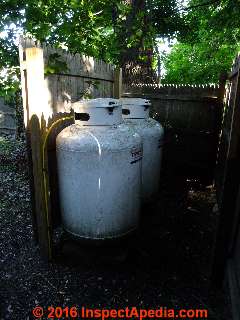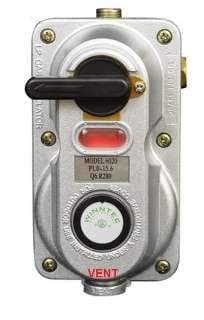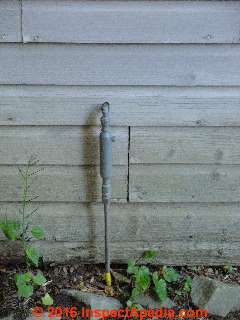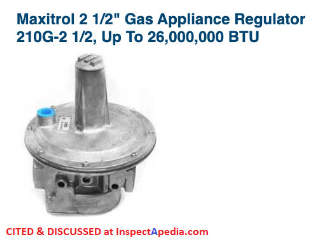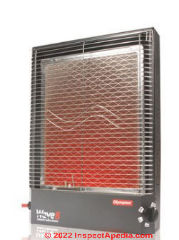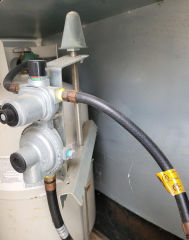![Gas piping in New Jersey (C) Daniel Friedman]](Gas_Pipe_HaddonfieldNJ_Gill_238_DJFss.jpg) Gas Piping Specifications
Gas Piping Specifications
- POST a QUESTION or COMMENT about LP gas pressure, propane gas pressure, and natural gas pressure in piping, at regulators, at appliances
LP or Propane Gas Pressures & Natural Gas Pressure questions & answers:
Questions, answers, FAQs about the common operating pressures of natural gas and LP or liquid petroleum gas at the gas regulators, in building gas piping and at gas appliances.
This article series gives the standard pressure ranges and pressure settings for LP gas, propane gas, and natural gas fuels, including pressures found in the distribution service piping, in the in-building gas piping, and at gas fired appliances such as gas stoves, clothes dryers, furnaces, boilers, and LP gas or natural gas fired water heaters. Since there several ways that people express gas pressures we include more than on description of common LP gas or natural gas system operating pressures in this article.
InspectAPedia tolerates no conflicts of interest. We have no relationship with advertisers, products, or services discussed at this website.
Gas Piping Materials, Sizes, Codes, Specifications for LP or Natural Gas in Residential Systems
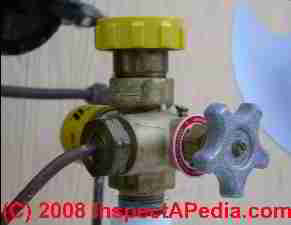
Question: Size of Gas Piping Required
2016/09/26 James w Howe Jr said:
I was taught to ALWAYS use copper flex with LP gas and black pipe with NG. I'm am NOT talking about pressure here! That stated, my supply is two 100 lb tanks with an "automatic switch over valve". The lines from the tanks to the valve are 1/8th inch.
I need to feed a 30 inch 5 burner gas stove with a convection oven, a gas clothes dryer and a tankless 10L water heater that has a 1/2 inch gas inlet.
Instead of running 1/2 inch copper flex with T's to each appliance, do i need to increase the volume in the system to have enough gas to feed all three appliances.
If I was using NG, i'd install at least a ten foot piece of 1 1/4 black pipe to build up the volume and then run 1/2 inch Ts with 1/2 inch pipe to the appliances.
With LP I'd use 3/8 copper flex for the dryer and stove and the 1/2 inch called for for the water heater, BUT, I need to get enough volume first so how should I proceed? All of the answers on your site deal with pressure and THAT is not the issue here!
Forgot my contact info: jwhowejr@centurylink.net
[Click to enlarge any image]
Reply:
Thanks for the comment and question, James, it helps us realize where we need to work on making our text more clear or more complete. A competent onsite inspection by an expert usually finds additional clues that would permit a more accurate, complete, and authoritative answer than we can give by email alone.
You will find additional depth and detail in articles at our website. See the ARTICLE INDEX link at the end of this article for a library of information about LP and natural gas piping, installations, equipment, pressures, regulators, etc. That said I offer these comments.
There's quite a list of types of piping material approved for use in gas piping systems; the distinctions I have seen are about the application - location such as above or below ground rather than the fuel difference between LP and NG; there have been, historically, opinions about gas piping and corrosion differences between the sources (hence the history of "dirt legs" on NG piping systems).
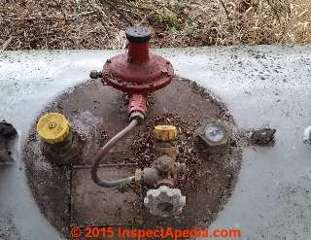 The list of gas piping materials - part of your question, depending on where the pipe is used, includes aluminum (in some locations and never below ground), brass (yellow - the old traditional gas piping found indoors in older buildings), copper type L or K rated for gas systems, iron (black ductile iron) above ground and possibly below ground in some jurisdictions, PE and PVC for outdoor underground use, and of course thinwall corrugated, coated flexible copper appliance connectors.
The list of gas piping materials - part of your question, depending on where the pipe is used, includes aluminum (in some locations and never below ground), brass (yellow - the old traditional gas piping found indoors in older buildings), copper type L or K rated for gas systems, iron (black ductile iron) above ground and possibly below ground in some jurisdictions, PE and PVC for outdoor underground use, and of course thinwall corrugated, coated flexible copper appliance connectors.
Watch out: Some jurisdictions such as New York City specifically prohibit use of some pipe materials such as cast iron, copper, brass, aluminum, and metallic tubing (with exceptions).
I haven't seen pipe approval distinctions based on fuel but I think some opinions on that stem from differences in fuel moisture and contaminants, hence the "dirt leg" we see on older iron gas piping systems; I think that we don't see galvanized iron because corrosives in NG supplies may cause coating loss and clogging; at the end of the day it's the local plumbing inspector whose word is law.
See NFPA #58 adopted by many jurisdictions permitting either type of steel piping as long as it's certified to meet ASTM A53 steel pipe standards;
Here's an excerpt example from a local city gas code pertaining to natural gas piping. LPG regulations will sometimes differ.
New NG gas piping can be of Schedule 40 steel pipe with threaded fittings, Type L rigid copper tubing with brazed fittings, Type L soft copper tubing with flared fittings, or flexible CSST (corrugated stainless steel tubing) with manufacturer provided fittings. - City of Brownton, MN 55312 www.cityofbrownton.com (outside Minneapolis/St. Paul MN).
Bottom line: to comply with piping materials choices, you need to find out what local building or plumbing inspectors will accept as rules vary by jurisdiction.
I agree that 1/8" diameter is not likely to provide adequate flow rates to multiple appliances nor over distance. Typically the plumber connecting multiple appliances uses a larger line to bring gas into the building.
Also see GAS PRESSURES LP vs NATURAL GAS - the home page for this topic.
There we discuss gas pressure drop in long runs or small piping sizes. You’ll see that pressure and pipe size and delivery rates are connected. P1V1 = P2V2.
Even for short piping runs there are recommended minimum pipe diameters. None of them in current standards for gas piping is 1/8”.
Gas tank switchover valves for multiple LP tank installations
For other readers, Automatic or manual switchover valves: I’m indeed not sure that we’re talking about the same device, nor that it has to do with gas piping size and pressure.
Switchover valves used, e.g. in Australia, Canada, the U.S., the U.K. and other countries switch between two LP tanks so that as fuel runs low in one LP tank the homeowner can switch to the full tank. We also call those also “changeover valves”. A changeover valve is particularly useful when the empty LP tank is to be physically swapped-out for a full one.
Changeover valves are sold in both manual and automatic forms. Some changeover valves are combined with a gas regulator as shown in our photo above. Shown is a Winntec Model 6020 P1.0-15.6 Q6.R280 LP gas regulator and changeover valve combined. This changeover valve is sold at plumbing and heating suppliers and at some RV suppliers such as campingworld.com.
Reader follow-up: you do know what NPT stands for, right?
019/09/26
James Said:
Why do [-es everyone I ask] seem to have to always go back to talk about pressure. My run is only about 10 feet so pressure IS NOT an issue! I also have to guess that you are completely unfamiliar with an automatic switch over valve. I realize that they are seldom used anymore, but if you don’t have knowledge of them, you should have passed the question to someone who does.
The last i knew, I live in the good ‘ol USofA and in this country, we have something called the National plumbing Code. Since I am not a licensed plumber, i do not have a copy so asked a question of a website that I thought could give me a reasonable answer.
To my dismay that is Not the case. Thanks, but no thanks, i’ll seek my answers elsewhere! By the way, the outlet on the automatic switch over valve is 1/2 inch NPT…you do know what NPT stands for, right? jwh,jr
Moderator reply: please be careful about quick, shallow "answers" to questions involving life safety
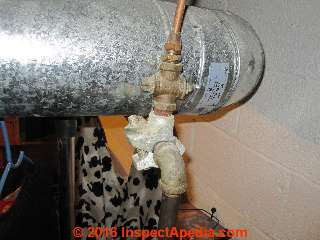 Of course pressure will be uniform throughout a system until appliances are using fuel. Then the pressure drop will depend on the length and size of piping. And use of a switchover or as we prefer changeover valve on LP tanks does not amend the requirements for gas piping sizing based on the flow requirements.
Of course pressure will be uniform throughout a system until appliances are using fuel. Then the pressure drop will depend on the length and size of piping. And use of a switchover or as we prefer changeover valve on LP tanks does not amend the requirements for gas piping sizing based on the flow requirements.
Sorry that our initial reply was confusing for you. We have readers in over 50 countries so we don't assume that we know where they live. "National Plumbing Code" itself is a standard that varies by country.
But in the U.S., the National Plumbing Code is not the best resource for answering your question. Instead you'll want to see NFPA 54 that you can access for free, online. We include the necessary information to do so at the end of this article.
Sorry also to see you so aggravated that your email digresses to insults. We try our best to serve millions of readers a month, finding information if we don't already have it, researching for authoritative, unbiased sources and eschewing arm-waving opinion.
Sometimes, depending on how your question has been worded, its length and content, we may not correctly understand the central question.
We also understand the natural wish of a reader who says "never mind all that malarkey, just TELL ME THE ANSWER". But sometimes the questioner appears to us to be facing life safety hazards as well as building code and standard, permits, or licensing issues that we think requires a bit more information to come up with a reasonable and safe solution to a problem.
InspectAPedia is an independent publisher of building, environmental, and forensic inspection, diagnosis, and repair information provided free to the public - we have no business nor financial connection with any manufacturer or service provider discussed at our website.
We are dedicated to making our information as accurate, complete, useful, and unbiased as possible: we very much welcome critique, questions, or content suggestions for our web articles. Working together and exchanging information makes us better informed than any individual can be working alone.
Watch out: It’s more important to understand that too high or too low gas pressures are unsafe, risking not just appliance malfunction but fire or explosion or fatal carbon monoxide poisoning.
For this reason, nobody, even the most generous plumber, if she or he has an ounce of sense, is going pretend that she can tell someone exactly what kind and size of gas piping is required for an installation about which she knows next to nothing.
The danger of giving a person of unknown training and skill “how to” advice is that there is almost always one or more important considerations that an on-site expert would notice but that are not offered by the person asking the question. When discussing fuel gas piping there’s the ever present risk that the reader later blow himself up or catches his building afire. That caveat made me continue to try to help you out:
Reader follow-up: so answer my question: how big should my gas pipes be? Do I need a manifold with multiple outlets?
016/09/27 James W. Howe Jr. said
Insults? I repeat my question: since there is only a half inch outlet on the switchover valve, should I use black pipe with LP to increase the volume since even with the new products on the market for LP, I haven’t seen any that have a diameter larger than three quarters of an inch OR should I simply put a short manifold on the valve outlet with three half inch outlets on it and run three half inch lines, one to each appliance? jwh,jr
Moderator reply: excerpts on gas pipe diameter & length & BTUH or Cubic Feet per Hour Gas Supply for NG or LPG from model gas codes & resources
Thank you for clarifying your question to focus on LP gas pipe size or diameter for a 10-foot length for an un-specified number of appliances or gas-fueled equipment.
Your original question mixed pipe type, pipe diameter, manifolds, fuels, tank changeover valves, and appliances of unknown input or BTUH requirements so we were not sure what answer would be most helpful.
You asserted that you’re asking just about pipe diameter and you don’t care about pressure, but it’s important to understand that it’s inadequate piping size (or improper regulators or regulator settings) that would deliver inadequate gas pressure (or flow rate in CFM per minute) at one or more appliances.
Typically the plumber measures gas piping pressure first with all appliances off, then with them on. If the pressure with all appliances using fuel falls below the required input pressure at the appliance regulators the plumber knows to choose among increase pipe diameter size or to go to a two stage regulator system.
A two stage regulator system is not normally required in a typical home gas piping installation.
You referred by email to lacking a copy of a model plumbing code such as the U.S. National Plumbing Code.
As you’ll read CHAPTER 4, GAS PIPING INSTALLATIONS, SECTION FGC 401, in the New York City Gas Code - provided free at InspectApedia.com as well as by New York City, or as you can read in what’s the best resource about gas piping installation, the National Fuel Gas Code NFPA 54, proper sizing of gas piping cannot be decided by arm-waving, shouting, nor insult.
Rather one needs to do some simple arithmetic, looking at piping lengths, diameters, fuel type, AND the input BTUH (or cubic feet of gas per hour) required the appliances on the gas piping system.
Watch out: beware of a simple "just give me the answer" demand for questions that are incomplete, for which a safe proper answer requires more information, and for which a hasty one-size-fits' all answer could kill you or others.
I can't answer your gas manifold question as that's a local plumbing decision based on space, convenience, and other factors suggested here.
LP Gas Pipe Sizing Codes, Tables & Examples
- 3/8" OD Copper tubing 10 feet long can support 49 KBTUH (Thousand BTUs/Hour) of gas flow or supply at 11 inches W.C. with a 0.5" W.C. pressure drop.
We're using this pressure range as it's most common for household appliances but you will need to check the specifications for your own appliances. - 1/2" OD Copper tubing 10 ft. long can support 110 KBTUH as above
- 3/4" OD Copper tubing 10 ft. long can support 348 KBTUH as above
- 1/2" iron pipe (of an approved type) 10 ft. of length can deliver 291 KBTUH as above
- 3/4" iron pipe 10 ft. of length can deliver 608 KBTUH as above
- See additional gas piping sizing tables and guidelines in the Codes and IO Manuals cited and provided below.
Note that these data points are for 11" W.C. gas line sizing & copper.
Different data than that given in the gas pipe sizing just above will be obtained if you are designing a 2 psig gas line.
What's the Difference between an 11" wc gas piping system and a 2 psig gas piping system?
11" wc is the most-common residential gas piping system but some new installations are being installed using a 2psig gas piping system. ("psig" refers to psi read on a pressure gauge or "gauge pressure".
11" W.C. (Water Column) = 0.397 psig.
Formula to convert pressure P to psi: psi = P / 27.679904842545
Or for convenience 1 psi = 27.7 in W.C.
What's the difference between PSI, PSIA, and PSIG?
PSI = pounds per square inch
PSIA = atmospheric pressure or pressure if measured compared to a pure vacuum. At sea level atmospheric pressure is 14.7 PSIA
PSIG = gauge pressure expressed in psi. Gauge pressure will show 0 at sea level. Since most building gas pressures are read using a pressure gauge it is proper to refer to psig or gauge pressure.
An example for 2psi piping systems is given below.
Maxitrol 325-series 2 psig Gas Pressure RegulatorGAS FLOW RATE from OPEN PIPE |
||||||
Flow of Natural GasLess Escape Volume 3 |
Length of Service Pipe |
|||||
| 25 ft | 50 ft | 100 ft | ||||
| BTUs | CFH | BTUs | CFH | BTUs | CFH | |
| 3/4" Iron Pipe @ 6" w.c. | 600K | 600 | 440K | 440 | 315K | 315 |
| 3/8" OD Tubing @ 2 psi | 210K | 210 | 148 | 148 | 105K | 105 |
Notes to the table above:
- For Natural Gas Maxitrol assumes 1000 btus / cubic foot of gas - this allows translation of cu.ft. into BTUs
- CFH = Cubic Feet per Hour
- Less Escapement Volume: Gas at 6” w.c. escapes from a 3/4” pipe at about three times the rate of gas from a 3/ 8” OD tube at 2-psi. The chart below shows flow comparisons at the discharge end. From the standpoint of uncontrolled escape of gas within a building, the 2-psi system has less flow than the 6” w.c. system.
- ANSI Z21.80 is the ANSI standard for line pressure regulators, intended for application in natural gas piping systems and LP (propane). Maxitrol’s 325 Series L-models are CSA certified (Z21.80) for 2-psi inlet pressure, with the 7 to 11 (inches w.c. outlet) spring.
- Source: MAXITROL 2-psi GAS PIPING SYSTEMS 325 Series GAS REGULATORS for DOMESTIC GAS PIPING [PDF] (2005) Maxitrol Company 23555 Telegraph Rd., P.O. Box 2230 Southfield, MI 48037-2230 U.S.A. www.maxitrol.com
- See also GAS BTUH, CUBIC FEET & ENERGY
- See also GAS PRESSURES LP vs NATURAL GAS
Gas Piping Sizing Codes, Specifications, Resources
- NFPA 54, ANSI Z223.1, (2015) The gas piping tables in NFPA 54 include a reminder of allowances needed to account for bends, fittings, valves - effectively those increase the effective "length" of the piping when figuring lengths and pipe size requirements. Similar gas piping size charts are given by LP gas suppliers. This standard provides minimum safety requirements for the design and installation of fuel gas piping systems in homes and other buildings.
As NFPA Explains NFPA 54 addresses the following:
Requirements cover the installation and operation of fuel gas piping systems, appliances, equipment, and related accessories, with rules for piping systems materials and components, piping system testing and purging, combustion and ventilation air supply, and venting of gas-fired appliances and equipment.
You can purchase a copy of the National Fuel Gas Code from NFPA at http://www.nfpa.org/codes-and-standards/all-codes-and-standards/list-of-codes-and-standards?mode=code&code=54
NFPA also permits viewing of NFPA 54 online, free if will take the time and trouble to register with the association. NFPA = the National Fire Protection Association, whom you can contact at
NFPA
1 Batterymarch Park
Quincy, Massachusetts USA 02169-7471
Telephone +1 800 344-3555 (U.S. & Canada) +1 617 770-3000 (International) - APPENDIX A: SIZING & CAPACITIES of GAS PIPING [PDF] as adopted in the U.S. by Virginia's adoption of the the IFGS and the National Fuel Gas Code will provide details of the information you need for an actual, safe answer to your gas piping questions.
- RESIDENTIAL PROPANE INSTALLATION GUIDE - GAS PIPING MATERIALS [PDF] Minnesota Propane Gas Association, PO Box 220, Princeton MN 55371, Tel: 763-633-4271, Website: www.mnpropane.org retrived 2020/05/08, original source: www.lakesgas.com/images/2019/Residential-Propane-Guide.pdf is another example that lists allowable gas piping materials
- "LP GAS LINE SIZING CHARTS", [PDF] LP-Gas Equipment Inc. 881 Hersey St. St. Paul, Minnesota 55114 USA, Phone (651) 646-1177 Minnesota: 800-652-9072 Out-of-State: 800-328-9222 E-mail: info[at]lp-gasequipment.com, retrieved 2016/09/27 original source: http://www.lp-gasequipment.com/products/pdf/LPGas_Cat2010_p157-175.pdf There you'll find the following tables:
- Gas pipe or tubing length vs. pipe size for 11" W.C. - gas line sizing chart for copper tubing & pipe
- Gas pipe or tubing length vs. pipe size for 2 PSIG - gas line sizing chart for copper tubing & pipe
- Gas pipe or tubing length vs. pipe size for 10 PSIG - gas line sizing chart for copper tubing & pipe
- Gas pipe or tubing length vs. pipe size for 10 PSIG - gas line sizing chart for polyethylene tubing
- Gas pipe or tubing length vs. pipe size for 10 PSIG - gas line sizing chart for CSST corrugated stainless steel tubing (Also see GAS PIPING, FLEXIBLE CSST)
- Liquid flow gas supply sizing charts rated in gallons per hour vs length of pipe and pipe diameter
- Gas equipment orifice size (and drill size) vs. BTUH capacity at various pressures
- Other tables, charts, calculations useful to gas piping installers and technicians
- MAXITROL 2 1/2" GAS APPLIANCE REGULATOR 210G-2 1/2 & 220 Series INSTALLATION INSTRUCTIONS [PDF] up to 26,000,000 BTU - (shown above) as offered by globalindustrial.com, retrieved 2021/02/09, original source: https://www.globalindustrial.com/
Website Excerpt:
The 210 Series Is A Lock-Up Type Regulator And Compiles With Codes Using This Specification. The 210 Series Has Been Designed For Maximum Control Function In An Easy To Use Package.
The Series Is Intended For Use With Gas-Fired Boilers, Steam Generators, Industrial Furnaces, Ovens And Similar High Demand Equipment. The Balanced Valve Design Eliminates The Inlet Pressure Effect Acting On The Valve. Regulating Stability Is Improved And Hunting Tendencies Reduced By The Use Of Dampening Mechanisms In Both The Breather Outlet And Sensing Tube.
You Get Precise Regulation Over A Broad Range Of Pressures And Flow Rates With The 210 Series, Including A "Zero Governor" Application. Made in the USA. - MAXITROL GAS REGULATORS CAPACITY CHARTS 210-series [PDF] (2006) Maxitrol Company 23555 Telegraph Rd., P.O. Box 2230 Southfield, MI 48037-2230 U.S.A. www.maxitrol.com and in Europe: Maxitrol Company 23555 Telegraph Rd., P.O. Box 2230 Southfield, MI 48037-2230 U.S.A. www.maxitrol.com - retrieved 2021/02/09, original source: industrialcontrolsonline.com
- SENSUS 243 GAS REGULATOR SPECIFICATIONS [PDF] (2013) Sensus Corp., 805 Liberty Boulevard, DuBois, PA 15801 USA Website: sensus.com/gas Tel: 1-800-375-8875
- SENSUS 243 GAS REGULATOR IO MANUAL [PDF] Op. Cit. - Includes Capacity Tables for natural gas for this regulator model.
In that reference you will see that for longer gas pipe runs, in excess of 100 feet, copper tubing in any size, 3/8" to 7/8" O.D. is not permitted and won't work.
Example Natural Gas Piping Code Excerpts
Here are a few explanatory excerpts from New York City's natural gas piping code; we provided some LP gas piping length examples in an earlier answer. :
401.3 [Natural Gas Piping ] Modifications to existing systems.
In modifying or adding to existing piping systems, sizes shall be maintained in accordance with this chapter.
401.4 [Natural Gas Piping ] Additional appliances.
Where an additional appliance is to be served, the existing piping shall be checked to determine if it has adequate capacity for all appliances served. If inadequate, the existing system shall be enlarged as required or separate piping of adequate capacity shall be provided.
401.3 Modifications to existing [Natural Gas Piping ] systems.
In modifying or adding to existing piping systems, sizes shall be maintained in accordance with this chapter.
401.4 Additional [Natural Gas Piping ] appliances.
Where an additional appliance is to be served, the existing piping shall be checked to determine if it as adequate capacity for all appliances served.
If inadequate, the existing system shall be enlarged as required or separate piping of adequate capacity shall be provided.
402.3 [Natural Gas Piping ] Sizing.
Gas piping shall be sized in accordance with one of the following:
1.Pipe sizing tables or sizing equations in accordance with Section 402.4.
2.The sizing tables included in a listed piping system’s manufacturer’s installation instructions.
3.Other approved engineering methods.
4.Individual outlets to gas ranges shall not be less than ¾ inches (19 mm) NPS .
402.4 [Natural Gas Piping ] Sizing tables and equations.
Where Tables 402.4(1) through 402.4(5) are used to size piping or tubing,
the pipe length shall be determined in accordance with Section 402.4.1, 402.4.2 or 402.4.3.
402.4.1 Longest [Natural Gas Piping ] length method.
The pipe size of each section of gas piping shall be determined using the longest length of piping from the point of
delivery to the most remote outlet and the load of the section
402.4.2 [Natural Gas Piping ] Branch length method.
Pipe shall be sized as follows:
1.Pipe size of each section of the longest pipe run from the point of delivery to the most remote outlet shall be determined using the longest run of piping
and the load of the section.
2.The pipe size of each section of branch piping not previously sized shall be determined using the length of piping from the point of delivery to the most remote outlet in each branch and the load of the section.
402.4.3 [Natural Gas Piping ] Hybrid pressure.
The pipe size for each section of higher pressure gas piping shall be determined using the longest length of piping from the point of delivery to the most remote line pressure regulator.
The pipe size from the line pressure regulator to each outlet shall be determined using the length of piping from the regulator to the most remote outlet served by the regulator.
Examples:
Using Schedule 40 Metallic Pipe and Natural Gas, where inlet pressure [at the appliance] must be less than 2 psi, the pressure drop in the system must be no less than 0.3" w.c. [Later tables in this reference allow grater pressure drop and then will support higher CFM of gas per hour for the same diameter and lengths of piping].
- 10 feet of 1/2" pipe (actual ID 0.622) can provide 131 cubic feet of gas per hour
- 10 feet of 3/4" pipe can provide 273 cubic feet of gas per hour
- 20 feet of 1/2" pipe can provide 90 cubic feet of gas per hour
- 20 feet of 3/4" pipe can provide 188 cubic feet of gas per hour
The codes I cite give detailed tables of pipe types, diameters, lengths, and the pipe's capacity to deliver some number of cubic feet of gas per hour. Take a look at your own appliances to see their requirements. Or you can look up typical appliance BTUH requirements in the documents we've cited.
402.5 Allowable [Natural Gas Piping ] pressure drop.
The design pressure loss in any piping system under maximum probable flow conditions, from the point of delivery to the inlet connection of the appliance, shall be such that the supply pressure at the appliance is greater than or equal to the minimum pressure required by appliance.
403.1 [Natural Gas Piping ] General.
Materials used for piping systems
shall be new and comply with the requirements of this chapter or shall be approved.
403.1.1 [Natural Gas Piping ] Pipe size and pressure limitations.
1. All requirements for installation of gas distribution piping with operating pressures at ½ psig (3.5 kPa gauge) or less and above ½psig (3.5 kPa gauge) shall be in accordance with Chapter 4 of this code.
2. Gas distribution piping operating at a pressure of over ½psig (3.5 kPa gauge) to 5 psig (34.5 kPa gauge) and size 4 inches (102 mm) or larger shall be welded.
Exception:
Manufactured and listed gas trains provided with the appliance may be threaded
3. All gas distribution piping operating at a pressure above 5 psig (34.5 kPa gauge) shall be welded.
4. All welding of gas distribution piping shall be subject to special inspection as set forth in Section 406.
5. All piping 4 inches (102 mm) and greater operating at pressure exceeding 5 psig (34.5 kPa gauge) must be butt welded, subject to special inspection and radiographed.
6.Threaded piping may be used up to 4 inches (102 mm) at pressure no greater than ½psig (3.5 kPa gauge).
403.2 Used [Natural Gas Piping ] materials.
Used pipe, fittings, valves and other materials shall not be reused.
403.3 Other [Natural Gas Piping ] materials.
Material not covered by the standards specifications listed herein shall be investigated and tested to determine that it is safe and suitable for the proposed service, and, in addition, shall be recommended for that service by the manufacturer subject to approval by the commissioner.
403.4 [Natural Gas Piping ] Metallic pipe.
Metallic pipe shall comply with Sections403.4.1 through 403.4.4.
403.4.1 [Natural Gas Piping ] Cast iron.
Cast-iron pipe shall not be used.
403.4.2 [Natural Gas Piping ] Steel.
Carbon steel and wrought-iron pipe shall be at least of standard weight and shall comply with one of the following standards:1.ASME B36.10, 10M2.ASTM A 53/A53M; or3.ASTM A 106.403.4.3 Copper and brass.
Copper and brass pipe shall not be used.
403.4.4 [Natural Gas Piping ] Aluminum.
Aluminum-alloy pipe shall not be used.
403.5 [Natural Gas Piping ] Metallic tubing.
Metallic tubing shall not be used except as provided in Section 405.5
Watch out: There are life safety hazards involved when fooling with gas piping and appliances. Check with your local plumbing officials about what type of gas piping are permitted where you live, and while you’re at it, ask what gas piping or plumbing permits and safety and code compliance inspections are required where you live.
Natural Gas Appliance Operating Pressures in WC, millibars, Pascals, PSI or ounces of pressure
A common operating pressure for natural gas appliances is around 7 inches of water column (WC) or re-stating this in equivalent measure, that's 14.9 millibars or 1743 Pascals or Pa, or about 0.25 psi (pounds per square inch) or about 4 ounces of pressure per square inch.
See NATURAL GAS APPLIANCE PRESSURES for details.
LP or Propane Gas Appliance Operating Pressures in WC, millibars, Pascals, PSI or ounces of pressure
A common operating pressure for liquid petroleum or LP gas appliance is 10" - 11" of water column (WC) or re-stating this in equivalent measures, that's 27.4 millibars or 2491 - 2739 Pascals or Pa, or about 0.36 - 0.40 psi or about 5.78 to 6.36 ounces of pressure per square inch.
See LPG & PROPANE APPLIANCE PRESSURES for details.
Reader Comments and Q&A
On 2022-11-30 by InspectApedia (Editor) - can used supplies be installed in pipeline again
@Hannah,
In my experience and OPINION most plumbers prefer to use new, clean parts for greater assurance that every connection is made well. Sometimes dried sealant on a re-used tapered NPT threaded fitting interferes with adequate tightening.
Be sure every joint is properly leak tested.
On 2022-11-30 by Hannah
Urgent question professional here, used supplies could be installed in pipeline again? like steel 1 inch pipe, connections? for around 30 feet distance. If there is excessive connections, would that be a concern for possible future leaking point? Thank you guys so much,
On 2022-09-10 by InspectApedia-911 (mod) - Flexible copper is often used for LP gas connections and piping
@Evan,
Flexible copper is often used for LP gas connections and piping.
Yes, you need a trained plumber or technician to do the work to be sure that it's safe.
DO NOT even think about using a heater that can consume oxygen you need to live in a space without:
1. being certain that the installation and use follow all of the manufacturer's instructions including their safety warnings
Confirm that this is the right manual for your heater, then see this CAMCO OLYMPIAN WAVE CATALYTIC HEATER MANUAL [PDF]
AND check with the manufacturer to be sure you're using this heater safely:
Camco Mfg. Inc.
121 Landmark Drive / Greensboro, NC 27409 USA
Phone: 800-334-2004 / fax: 336-668-2049
www.uscatalytic.com · info@camco.net
2. ensuring that you have working CO and smoke detectors as well as an adequate supply of combustion air to the heater.
Making a mistake can be more expensive than those terrible gas bills.
On 2022-09-10 by Evan
Hi there . I'm a full time RVer on its own lot up here in Alberta Canada. It gets like - 40 Celsius here at times during the winter .. and the cost of propane and electricity went through the roof last spring and so I bought a olympian wave 8 ( 8000btu max) catalytic heater .
Apparently I need to hardpipe a line into my 37 ft fifth wheel ( that's what the propane company said . Requires a gas fitter they said . I do want to be safe ( yes I will allow ventilation) is there a easy way to do this ? I have a large 400lb tank that goes into the tree where the propane bottles would go .
Can a copper line replace the hose and come up into the trailer through the floor and then I can connect to the heater ? This heater would be much more efficient..but I realize there are hazards to it . It burns oxygen in the space. What would be the best way to hook it up?
If it is hooked up to the tree there is less issues with the cold freezing as smaller bottles won't work in extreme cold very well . Can you help ? Would copper or another pvc type gas line be easily hooked up ? I have a gas fitter friend at work that can do it .
On 2022-07-08 by InspectApedia-911 (mod)
@L Boardman,
Quite so. You're spot on. I think where that leaves us is that the code doesn't cite every possible material choice. What I do in this circumstance is ask what the local building official will accept.
More common is flexible stainless steel used for gas piping, as you say, most likely less costly than rigid stainless steel piping both to buy and to install.
The article above on this page
describes the materials usually installed.
On 2022-07-08 by L Boardman
Thanks for the response. I had read the cited code, but it does not specifically address my question. The phrase "Schedule 40 steel pipe", would it include Stainless Steel pipe, either type 304 or 316? Or does it limit installations to carbon steel piping (not stainless steel)?
Stainless steel appears to be an accepted material because it is allowed in the flexible, corrugated design, but I cannot find any specific reference (pro or con) regarding Sch 40 or Sch 80 rigid stainless steel pipe.
On 2022-07-07 by InspectApedia-911 (mod)
@L Boardman,
Residential gas code cited above on this page...
New NG gas piping can be of Schedule 40 steel pipe with threaded fittings, Type L rigid copper tubing with brazed fittings, Type L soft copper tubing with flared fittings, or flexible CSST (corrugated stainless steel tubing) with manufacturer provided fittings.
If I have missed or misunderstood something in your question do let me know.
On 2022-07-06 by L Boardman
I am planning to install propane service into a 1970's all electric home for heating and cooking. The house is frame construction with an accessible lower crawlspace. The tank will be about 150 ft. from the house with underground piping. Can I use S/S piping (ASTM A312) or S/S tubing (ASTM A213)?
I work with natural gas equipment at an industrial level and both of these are specified frequently, but they do not seem to be recognized by residential codes.
Perhaps specific references are not included due to the increased cost of S/S over black steel or are there other considerations that make S/S avoided for residential installations? Or maybe I'm just not looking at the best document sources. The house is in California.
On 2021-11-30 by Inspectapedia Com Moderator
@Scott Hall,
Apologies if I'm misunderstanding your question, but why wouldn't you simply use the same diameter gas line as the diameter of the service already installed?
For flexible lines
see GAS PIPING, FLEXIBLE CSST
On 2021-11-30 by Scott Hall
I need to run copper 4 feet from a home flex wall termination to my regulator. What size copper should I use?
On 2021-11-04 by Inspectapedia Com Moderator - inadequate gas flow to backup generators
@Doug Kraus,
Indeed inadequate gas flow to backup generators has been a common problem that many of our readers have encountered.
You'll want to see our article:
BACKUP ELECTRICAL GENERATORS
where we include two sections you should review with care:
GAS PRESSURE FLOW INADEQUATE
GAS SUPPLY for ELECTRIC GENERATORS
The FAQs for that page also include quite a few reader reports on LP or propane or even natural gas pipe sizes and lengths for generators - so you can see where trouble has occurred.
On 2021-11-03 by Doug Kraus
What size copper gas tubing to run 80 ft to my propane 8125 watts peak generac 6500e generator
On 2021-10-11 by inspectapedia.com.moderator
@Tami,
Where are you come install gas piping that will accommodate either natural gas or propane. You'll probably want to use black steel piping with appropriate fittings.
On 2021-10-05 by inspectapedia.com.moderator - Can the house be plumbed with piping that accommodates both propane and natural gas?
@Tami,
The two are not interchangeable; each type of fuel requires special gas utilization fittings. If you want to switch between the two, you'll need a conversion kit for the appliances and must follow the manufacturer's specifications for the installation process.
Read more about the procedure for this conversion at:
HOW TO CONVERT A HEATING APPLIANCE FROM LP TO NATURAL GAS
On 2021-10-05 by Tami
New house construction
Can the house be plumbed with piping that accommodates both propane and natural gas? It will initially be propane but could have natural gas available at a later date. Thanks!
On 2021-05-24
by (mod)
- Can I use a 3/8 propane hose to run a natural gas barbecue?
@Joe,
Here is a propane-to-natural-gas connector kit - this example is the Permasteel Natural Gas Conversion Kit for Kenmore Grills 6-Burner + Side Burner.
As you can see, those are different materials.
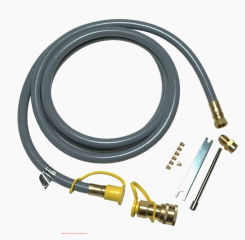
Watch out: Some gas connector lines, but not all of them, are rated for both LPG and natural gas fuels.
I would not use propane gas connectors nor other parts on a natural gas barbecue BEFORE reading the specifications for your specific product.
Below is a connector hose described as rated for propane gas.
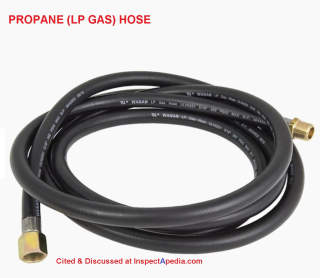
Take a look at the materials and also take a look at the requirements to convert a gas grille from Propane to Natural Gas - my second illustration I'll post in a minute.
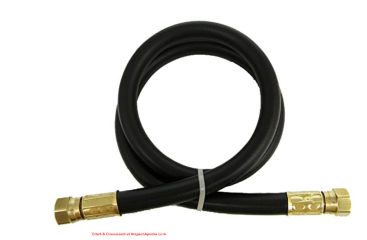
Bottom line:
You MIGHT be able to use the same hose for connecting to EITHER Propane or Natural Gas **if** the hose is specifically rated for both fuels.
An example is shown below, from M.B. Sturgis Co., a hose that is specifically rated as OK for either fuel (shown as sold at Amazon) described as
3/8" ID Thermo Rubber High Pressure Propane/Natural Gas Hose with 3/8" 45 Degree Female Flare Swivels on each end.
Versatile hose can be used for any Propane or Natural Gas Appliance connection. The Female Flare Swivels make connecting to the supply or appliance easy.
Thermo Rubber Hose stays very flexible in cold weather.
350 PSI Max Pressure Rating
Certified to UL21, UL569, CAN 8.3
shown above
On 2021-05-24 by Joe - Can I use a 3/8 propane hose to run a natural gas barbecue?
Can I use a 3/8 propane hose to run a natural gas barbecue
On 2021-05-07 - by (mod) -
@STEVEN ALTMAN,Thanks, that's an interesting question; for which I cannot give an authoritative answer, as might a suitable civil or plumbing engineer.
I suspect that the distances are so short that what you propose is fine, but technically it's a flow question that could use engineering calculations.
Or you'll try the 1" and monitor the result; for short distances like that re-plumbing sounds minor.
On 2021-05-07 by STEVEN ALTMAN
my customer is adding an additional ng hot waster pressure washer to his facility. presently, he has 2 units rated at 415,000 btu's. The additional unit will be the same. The 2 units are individually connected to a 2" main with shut offs and regulators. The new unit will be located next to a existing unit supplied from a 1" black pipe approximately 10" from the 2" supply line.
if possible, we would like to plumb into the existing 1" line for the additional unit which will be located about 10' away. Do you see this as a problem? What size black pipe line would be required for each individually for this 415,000 btu requirement ?
From the above data, it seems that a 3/4" line at 25' is rated at 600,000 btu's so a 1" would seem to be adequate..do you agree ? thank you.
On 2021-02-10 - by (mod) -
Travis:Take a look at the input pressure that is specified on the LPG regulator that is provided with the powder-coat oven you are installing. If your supply pressure is greater than that you'll want a step-down regulator just ahead of the oven.
That's a common approach when having to deliver high gas supply rates over longer piping runs: distribute at higher pressure and drop down at the appliance;
Thank you for your tongue-in-cheek comment too.
80 ft is pretty long; if you don't run the larger line to closer to your burners you may find inadequate gas flow.
On 2021-02-10 by Travis
Thank you for the quick response..I have a couple of other questions. I'm planning on running 1 1/2" iron from a regulator like the examples to within a foot or two of furnace.. Adapting down to a 1 1/4 flex line for final connection.
Do I need another regulator of some sort at the end of the 1 1/2 iron pipe.
Second question is regarding the connection of tanks to first regulator. Should I use both tanks simultaneously to feed supply line and if so would I just use the appropriate size pipe from each tank into a tee and then into regulator..
Last but not least a hats off and big thanks to all who are involved in running this website...and I'm impressed with mod's ability to keep pen in cheek when dealing with jackasses like James from above...THANK YOU!!
Apologize if this a duplicate comment I don't know if my first one got sent or I somehow just managed to erase it...
On 2021-02-09 - by (mod) - basic gas piping diameter and length limits
Continuing:More examples of high BTUh gas regulators include this Sensus 243-12 model.
Also see these examples of gas regulator specs and IO manuals that include helpful sizing tables; more sizing tables are in the article above.
SENSUS 243 GAS REGULATOR IO MANUAL [PDF]
SENSUS 243 GAS REGULATOR SPECIFICATIONS [PDF]
Travis:
In the article above you'll find the basic gas piping diameter and length limits at
"LP Gas Pipe Sizing Codes, Tables & Examples"
and just below that links to PDF files giving detailed gas pipe sizing tables that relate BTUs and piping lengths that will work.
I suspect you will need AT LEAST 1 1/4" pipe over that 80 ft. run.
And even though that 1/4" ID line between LP tank and regulator is quite short, your BTUh consumption 1.2 million is so great that most-likely the whole regulator and pipe diameter need to be increased. Take a look at the regulator brand and model, then give its manufacturer a call.
It's likely that you will need a larger capacity primary regulator at the LP tank; an example is shown below; often we see that for a high BTUh application like yours the gas is run from tank to appliance at higher pressure and then is stepped down by a secondary regulator just ahead of the appliance.
The regulator I show below, the Maxitrol 2 1/2" Gas Appliance Regulator 210G-2 1/2, can deliver up to 26,000,000 BTU and is probably a higher capacity than you need, but other models (at lower cost) are of course available.
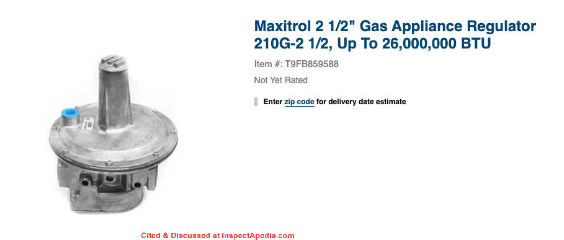
On 2021-02-09 by Travis
I'm installing a large powder coat oven in my shop. 20'x10'x10" it is a propane heated unit...The unit has a max. burn rate of 1.2mil BTU and 1 1/4 inlet for propane.
The tanks used for propane supply are two #420 tanks located approximately 80ft away and 12ft below the burner. Do I need to run 1 1/4 pipe all the way back to the propane tanks and will the 1/4" copper line off tank to regulator allow enough fuel to run heater...Thank you
On 2021-01-18 1 - by Linda - I installed 50ft of 3/4" black pipe
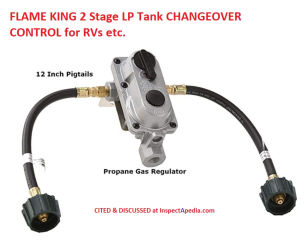 Linda
Linda
That regulator you show is intended for use on an RV or camper and is not intended to serve a building with longer gas line runs; I suspect that it is very under-sized and may not be approved for the use you have made of it.
On 2021-01-18 - Linda McPherson
[Re-posted with illustration replacing link - mod]
Ok, I installed 50ft of 3/4" black pipe when I remodeled this barn. My plan, to use LP for furnace, dryer, range that was 5 years ago. Plans changed.
The lines were tested and tight at that time. All capped. I decided to install a gas range so I pressure tested the lines, made corrections to couplings that were soap tested and showed leaks.
Retested. Everything is good. The line is clear. Bought a new dual stage regulator and two tanks. [from Amazon -shown below] Installed a 3/8" black hose to ;my black pipe.
This regulator indicates that the tank is empty but I'm wondering if my black pipe line is too long and the pressure is the line is too low to get the gas to my range which would cause the valve in the regulator or the valve in the tank to close.
On 2021-01-18 - by (mod) - gas not getting to range
You need to be a little more clear on exactly where you are detecting no fuel.
I'm not aware of any gas regulators at appliances that tell us anything about the quantity of fuel available in the lp tank.
Even if your piping is under sized for the length you would still see some gas flow, it would just be at too low a rate or pressure.
So let's start by being sure that there's no valve closed somewhere in the system.
Watch out: if you're not familiar with proper and safe gas piping this is not work you should attempt yourself as a mistake could blow the place up.
On 2021-01-17 by Linda McPherson
I am installing two 40# lp tanks to supply my range in my home. I have a long run (50ft) of 3/4" black pipe to my kitchen. When I finished installing the tanks, regulator, and connections the regulator shows my tanks are empty (just filled) and no gas is getting to my range.
Everything has been pressurized and soap tested so there's no leaks. I'm wondering if I need a higher pressure regulator, bigger tanks, or a shorter run. Any ideas?
On 2020-12-19 - by (mod) -
Forrest
Thank you very much for your generous comments. I've worked hard on this material for a long time and so I'm particularly grateful when readers find it useful.
Your questions, comments, criticism, or content suggestions are also always welcome and helpful.
On 2020-12-19 by Forrest
thank you so much for your very detailed article. Some people have to be jerks even when they are getting free help . I learned a lot! Thanks again
Forrest
On 2020-12-14 by James fricks
we are going to run a line for propane gas about 60-65 ft, to the house. we have a 250 gal. tank. are all the different materials (coated flexible copper, alum, stainless steel) equal as far as safety and durability?
On 2020-10-24 - by (mod) -
TF
Please find your question and my detailed reply now near the top of the article above on this page. You may need to clear or refresh your browser cache to see the updated page. We welcome your further photos, comments, questions.
On 2020-10-20 - by (mod) -
TF
Indeed there are plastic-coated LP gas piping materials that are rated for outdoor and for either above-ground or for buried (underground) use. Those are described on the page above and at
GAS PIPING, FLEXIBLE CSST
For long gas runs you often need to add a regulator.
On 2020-10-20 by tfcrotty
I have a 250 gallon propane tank and have 22kw generator hooked up to it. I am in the process of having a concrete deck poured and was wondering if I should go underground with the propane pipe to the house fireplace(vented logs) which has never been hooked up, I would like to have an outlet on deck for a propane BBQ pit.
The tank is about 110' away from the fireplace connection and the location where I want to add for the bbq is about 50 ft. Wondering what is best material to run and do I use tee or header underground/above before it goes into decking. As well as do I need additional regulator?
On 2020-09-29 - by (mod) -
Garnett In the article above you'll see some propane piping size guidelines and examples.
3/8" OD Copper tubing 10 feet long can support 49 KBTUH (Thousand BTUs/Hour) of gas flow or supply at 11 inches W.C. with a 0.5" W.C. pressure drop. We're using this pressure range as it's most common for household appliances but you will need to check the specifications for your own appliances.
So you can see that to go 25 ft you need a larger size.
On 2020-09-28 by garnett
I am hooking up a 30,000 btu propane gas free standing stove heater and need to run copper pipe for aboutn25 feet just wanting to know if I should run 3/8 pipe or 1/2 pipe
On 2020-07-22 by Sundrop
I purchased a small 60 gal auxiliary lp tank in case emergency and water heater during summer.i have some questions about hooking it up.
This was used on an rv that ran on LP. Therefore, I had to purchase a vapor valve since rv used liquid LP. Doesn't have a regulator.
1--does the brass fitting that attaches to the tank for vapor need to have pipe dope/tape?
2--can lp from this tank be ran into the existing regulator? Small tank will only be used in the situations above. The output will go into the larger tank.
3--can CSST be used to hook both tanks together with or w/o protection from weather? Thanks for any answers or comments.
On 2020-01-12 - by (mod) - installing a gas generator in Iowa
Mike
I'm certainly not absolutely certain but your best chance for success is to use a large diameter gas line 5/8 in for example.
The number one complaint I hear from people trying to run a generator is inadequate flow - is usually because of using too small a diameter piping on a long run. Keep me posted.
On 2020-01-12 by Mike
Trying to determine if I can run an emergency portable generator off the house LP supply line (with bulk tank) and not affect the furnace.
I am doing this for a friend who has a medically dependent (on electricity) child. The supply line from the bulk tank to the house is 3/8" OD copper after the regulator.
At the house is a second regulator with a 5/8" OD copper line on the output that then runs directly to the furnace - probably 4' of 5/8" OD piping. No other LP appliances/uses. I am hoping to tap a line off the drip leg of the furnace piping and run over to the generator using soft copper tubing.
The furnace drip leg is 1/2" B.I. NPT pipe. The generator is a 12,000 watt (peak), driven by a 18 HP engine.
The generator location requires an approximately 40' supply line (from furnace to generator).
The generator comes with a primary regulator (intended for connecting to a 20# or 40# cylinder) and a secondary regulator mounted on the generator.
I do not currently know the furnace BTU but the house is an older two story farm house.
Also, I live in Iowa where winters can be quite cold at times. My concerns? I want to ensure I have the proper line size feeding the generator AND I do not want to "starve" the furnace when the generator is running. Any help would be greatly appreciated. Thank you.
On 2019-12-13 - by (mod) -
Nope, Terry, In my view as long as the 3/4" NG regulator has the same pressure and flow ratings, the only difference is the pipe fitting size - that ought not hurt a thing as you'll simply have to use the proper pipe fittings to step down from 3/4" to 1/2".
On 2019-12-13 by Terry S. Whitehouse
I purchased a 3/4" NG regulator by accident to replace 1/2" regulator for NG Grill. Both have same output (7 inch WC). Should I expect failure here?
On 2019-11-25 - by (mod) -
Not necessarily, Edward; the pressure and diameter alone won't tell the story; the piping length and other restrictions may also mean you need a larger diameter. You'll see details in the article on this page.
On 2019-11-24 by Edward roy
trying to connect 7500 duel fuel generator with 7,500 running wattage to home propane line will 1/2" sch. 40 black pipe be sufficient the generator people say requires 1.2 cfm at 7-11 inches of water?
On 2019-11-16 by Barbara C.
@Barbara C.,
Thank you for your response, Dan. I will check with the propane supplier too. This site is a great source and I appreciate the work involved to maintain it.
Best,
Barbara
On 2019-11-14 - by (mod) - can chipmunks eat through the metal gas lines
Barbara
A google Scholar search for "rodent damage gas piping" and similar phrases turned up articles on rodent-proof construction but no specific article (at least not in the first few pages I scanned) reporting an incident of rodents chewing through metal gas piping.
I'm waaay too scared to bet your life on arm-waving but I suspect that when squirrels or other rodents chew through gas lines it's plastic or PVC piping that they attack, not copper or iron piping.
If you actually see bite marks or scratches on any of the piping that'd up the concern and I hope that in addition to calling your plumber you'll post a photo of that piping here.
On 2019-11-13 by Barbara C.
Propane tanks that supply the heating boiler in my home have slim metal pipes traveling from the tank, across the back of my house and into a larger pipe that enters the boiler room. I have found chewed nuts in the area at the top of each tank that shelters the gauges that indicate the number of gallons in the tanks.
I am concerned as to whether the chipmunks could eat through the gas lines.
There's a large population of chipmunks and squirrels near my home due to a grove of adjacent nut trees. Chipmunks have chewed through wires in my engine several times so this is not an academic or theoretical question. Thanks.
On 2019-07-01 by Jim S.
I was very clear regarding what I was going to use. I was standing right next to the pipe and pointing to them. Either he is overly cautious or had no idea what he was doing. He did confirm that he was a plumber. Any thoughts on the plan. I also wanted to note that all connections would have PTFE (gas rated) tape. I do know that the flared heads do not require tape. Thanks for your help! JIm
On 2019-07-01 by (mod) - using black iron or steel pipe for gas
Jim
Your Home Depot plumbing rep may have thought you were talking about using black PLASTIC pipe such as ABS.
Black iron pipe is the traditional and correct plumbing material for LPG and Natural gas. Here is what the Home Depot link says:
Strong and durable black steel pipes (a.k.a. Black Iron, Black Malleable) are used to transport natural and propane gas from the street or a tank to the home. Good for fire sprinkler systems because of heat resistance.
Hub-and-spigot cast iron pipes should be installed by professionals. Comes in a variety of lengths from 2 inches to 10 feet and diameters of ¼ inch to 2 inches.
On 2019-06-28 by Jim S.
I'm looking to build (an unusual) charcoal grill with a propane starter. I've done some research and scoured the web for information. At this point, I know enough to be dangerous and by no means an expert (why I'm asking here).
I went to the Home Depot plumbing department for some information. When I explained that I was thinking of using black pipe for the starter, the representative almost had a heart attack, berated me, told me that I would end up on the news for blowing myself up.
I was simply trying to get some information and he refused to help and he told his associate to not talk to me because it could be a lawsuit.
My question is, is it safe to use schedule 40 black pipe as a propane burner? I was also wondering if the attached image of my plan would be viable or too dangerous to try. As a charcoal starter, it would only be used for 10-20 minutes max. Is that too long and melt the pipe? Any help would be greatly appreciated.
Thanks in advance!
Jim
P.S. What's really funny is that the Home Depot website states that black pipe can be used for LP delivery.
On 2019-06-19 by Anonymous
Can you substitute ppr for ppe for lpg gas line? Thanks
On 2019-02-19 by (mod) - how to adjust the gas pressure at the regulator
Sam
I don't know the expertise of the person who advised you that individual appliance regulators are not needed, but my view is the safest and best approach is to check with the manufacturer of the specific equipment by brand and model, or if you have the installation and operation manual for your fryers start there.
In my experience appliances expect their own local regulator and the manual writers assume one will be provided if it is not already an integral part of the appliance.
Here is an excerpt from a commercial fryer installation manual:
To adjust the pressure, remove the regulator adjustment
screw cover (see the Gas Valve illustration.) Remove the
cover cap. Use a flat tip screwdriver to adjust the screw until
the correct pressure is reached. (clockwise will increase the
pressure, counterclockwise will decrease the pressure.)
Source: Pitco Fryaltor IO Manual, Installation, Operation and Maintenance Manual for Fryer Model Numbers 7,12,14,14R & 18
Gas Fryers With Options and (F) Built-In and UFM (Spacefighter) Filter Systems - retrieved 2019/02/19 original source: https://www.heritageparts.com/medias
Note that the instructions for your fryer brand and model may differ.
On 2019-02-19 by Sam
Hi mod, I'm sorry it is black iron pipe not galvanized sorry.
My flat top my steam table and my funnel cake fryer all have a regulator that came from the factory but my 270-pound fryers do not one of the person told me that considering it was a hundred fifty thousand BTUs per fryer and I had a 525000 PT you regulator did I would not need a regulator on that system is this true and should I go with 3/4 inch hoses from my black Iron to my equipment
On 2019-02-19 6 by (mod) -
Sam you might want to check with your local build department / plumbing inspector since galvanized pipe is often prohibited in favor of black iron pipe for gas piping.
Normally each appliance has its own gas regulator.
On 2019-02-19 by Sam
I am installing two fryers a flat top and a steam table. I am using 3/4 inch galvanized pipe and then I'm running it to my equipment should I use 3/4 inch hose since I'm using 3/4 inch pipe with reducers to the half inch on a couple of pieces of equipment I also have a 525000 BTU low pressure regulator do I need to have a regulator on each piece of equipment if it did not come with it from the factory
On 2018-12-20 by Mike
Hi. I'm trying to replace my indoor electric washer/dryer but just discovered there's a capped propane pipe sticking out of the wall horizontally. It's in the way. If I have to go through the time/money/hassle of shortening it, I might as well stick it in the wall.
I've seen outlet boxes for washer hot/cold/drain fittings and also outlet boxes for ice makers. I'm wondering if I could use one of those boxes for this application.
The ice maker box seems perfect, although I'd have to widen the hole to accomodate the diameter of the presumably black iron piping. Would such a box be safe? Is there a better, pre-existing option? And depending on what is needed (haven't opened the wall yet), is a black iron plug just as safe as a black iron cap?
In an ideal situation, just need that cap/plug and PTFE gas line tape, right? And of course an outlet box or something similar. Your help is greatly appreciated.
On 2018-11-14 by (mod) -
Barbara,
Brass fittings are commonly used in gas piping
However galvanized piping is not recommended.
On 2018-11-14 by Barbara
I was wondering if when installing gas range I used a 3/8 elbow screwing it onto theGal nip coming off gas range and then a 3/8 brass nip going into regulator will it make a diffence because it’s not black fittings ? Will it corrode?
On 2018-06-01 by (mod) - Would it make sense to always plumb a house for Natural Gas
Nathan
That sounds like a fine idea and ought to be ok - let me know if your plumber has a different opinion.
On 2018-05-31 by Nathan
Would it make sense to always plumb a house for Natural Gas. Natural Gas is available down the road but not at my house yet. I would use Propane until it becomes available. I know Natural Gas typically requires larger pipe than propane would it cause any issues for the propane?
On 2018-05-04 by (mod) - Does l.p. gas have to have a yellow jacket
No, as some older LPG piping including copper and flexible copper were copper colored or gray-coated;
but you will see that newer flexible gas lines and piping are typically coated with a yellow surface that helps resist damage.
On 2018-04-2 by John
Does l.p. gas have to have a yellow jacket
...
Continue reading at GAS PIPING, VALVES, CONTROLS - topic home, or select a topic from the closely-related articles below, or see the complete ARTICLE INDEX.
Or see
Recommended Articles
- GAS APPLIANCE CONVERT LP-to-NATURAL GAS
- GAS BTUH, CUBIC FEET & ENERGY
- GAS BURNER SOOT CAUSE & CURE
- GAS LEAK DETECTION, LP / NG
- GAS PILOT WON'T STAY LIT
- GAS PIPING, VALVES, CONTROLS - home
- GAS PRESSURES LP vs NATURAL GAS
- GAS PRESSURE vs BUILDING HEIGHT
- GAS PRESSURE FLOW INADEQUATE
- GAS COOKTOP INSTALLATION
- GAS REGULATORS & APPLIANCE / HEATER CONTROLS
- GAS REGULATORS for LP TANKS
- GAS SUPPLY for ELECTRIC GENERATORS
Suggested citation for this web page
GAS PIPING SIZE & MATERIAL at InspectApedia.com - online encyclopedia of building & environmental inspection, testing, diagnosis, repair, & problem prevention advice.
Or see this
INDEX to RELATED ARTICLES: ARTICLE INDEX to GAS APPLIANCES, PIPING, CONTROLS
Or use the SEARCH BOX found below to Ask a Question or Search InspectApedia
Ask a Question or Search InspectApedia
Try the search box just below, or if you prefer, post a question or comment in the Comments box below and we will respond promptly.
Search the InspectApedia website
Note: appearance of your Comment below may be delayed: if your comment contains an image, photograph, web link, or text that looks to the software as if it might be a web link, your posting will appear after it has been approved by a moderator. Apologies for the delay.
Only one image can be added per comment but you can post as many comments, and therefore images, as you like.
You will not receive a notification when a response to your question has been posted.
Please bookmark this page to make it easy for you to check back for our response.
Our Comment Box is provided by Countable Web Productions countable.ca
Citations & References
In addition to any citations in the article above, a full list is available on request.
- Bosch, "Gas Cooktops Installation Manual, NGM Gas Cooktops (NGM30, NGM50, NGM 56, NGM80, NGM86, NGMP65)", (2013), Bosch, 1901 Main St., Suite 600, Irvine CA 92614, Tel: 800-944-2904, Website: www.bosch-home.com
- Bosch, "LP Gas Conversion Kit Installation Manual , NGM Gas Cooktops (NGM30, NGM50, NGM 56, NGM80, NGM86, NGMP65)", (2014), Bosch, 1901 Main St., Suite 600, Irvine CA 92614, Tel: 800-944-2904, Website: www.bosch-home.com
- Bosch, "Gas Cooktops Use and Care Manual, NGM5055, NGM8055, NGM8065, NGMPO55, NGM5655, NGM8655, NGM8665, NGMP655", (11/13), Bosch, 1901 Main St., Suite 600, Irvine CA 92614, Tel: 800-944-2904, Website: www.bosch-home.com
- Columbia Gas, "Standards For Customer Service Lines,
Meters, And Service Regulators
(plumber’s Guide)", Columbia Gas Company, Columbia Gas of Ohio,
1600 Dublin Rd.,
Columbus, OH 43215 (2010), retrieved 13 June 2015, original source: https://www.columbiagasohio.com/docs/contractors-plumbers/plumbersguide.pdf
Columbia Gas Standards
“Standards for Customer Service Lines, Meters, and Service Regulators” (Plumber’s Guide); New Tap and
Meter Process, Materials for Customer Service Lines, Standard Drawings for Meter Settings, Operator
Qualification Card, and Plumber’s Guide Revision Proposal Form are available for Ohio on the internet at:
www.columbiagasohio.com/ and for Pennsylvania and Maryland at: www.columbiagaspamd.com/ - O'Brien, Jim, "CLAS Safety Seminar", Connecticut Lighter than Air Society, (2010), retrieved 4/28/14, original source: http://www.unitoops.com/Propane%20Safety.pdf
- NIST "Property Availability: Properties of Propane", NIST/TRC Web Thermo Tables (WTT) NIST Standard Reference Subscription Database 3 - Professional Edition Version 2-2012-1-Pro , U.S. Secretary of Commerce, ret rived 4/28/14, original source: http://wtt-pro.nist.gov/wtt-pro/index.html?cmp=propane#propane/ aa1;374,264,507,424/A;0,0,507,424;help,about/aa2;28,45,507,623/
- Venera Brinzea, Maria Mitu, Codina Movileanu, Adina Musuc and Domnina Razus, "Expansion Coefficients And Normal Burning Velocities Of Propane-air Mixtures By The Closed Vessel Technique:, University of Bucharrest, Analele Universatati Bucuresti, Department of Physical Chemistry 4'12 Regina Elisabeta Blvd, District 3, Bucharest phone: +40'21'3143508; fax: +40'21'3159249 p ISSN: 1220'871X e ISSN: 1844'0401, ARS DOCENDI PUBLISHING HOUSE Sos. Panduri 90, District 5 Bucharest phone/fax: +40'21'4102575 e'mail: arsdocendi@yahoo.com
- American Gas Association, 400 North Capitol Street, NW | Washington, DC 20001, web searhc 08/25/2011, original source: http://www.aga.org/Kc/aboutnaturalgas/consumerinfo/
Pages/NGDeliverySystem.aspx - National Fuel Gas Code, ANSI Z223.1-yyyy - American Gas Association / National Fire Protection Association
- LP-Gas Serviceman's Handbook,Fisher-Rosemount, Fisher Controls
- National Fire Protection Association (NFPA) Pamphlets No. 54 and 58.
- Specifications for Gas Installations, Central Hudson Gas and Electric Corporation
- "Gaslight", Gary Quilliam, The Old House Journal, March/April 1989 article describes fixtures, modern fixtures, and sources of supply.
- Residential Gas Hot Water Heater Pocket Partner - Testing and Trouble Shooting, 19. State Corp., Ashland City, TN 37015
- Gasco, "Propane Safety, Propane Properties", Gasco, Green Bay Wisconsin, Tel: 1-800-589-2244, Email: sales@gasco-propane.com, Retrieved 4/28/14,original source: http://www.gasco-propane.com/Files/safety.html
- J. C. Ramirez, R. A. Ogle, A. R. Carpenter, and D. R. Morrison, "The Haards of Thermal Expansion",
Exponent Failure Analysis Associates
1011 Warrenville Road, Suite 215
Lisle, IL 60532
Phone (630) 274-3225
ABSTRACT
We examine the sometimes overlooked hazards posed by thermal expansion of trapped liquids in piping systems. Trapped liquids can generate large pressure increases with only modest temperature changes. This phenomenon is well understood by the process safety community. However, it is also a phenomenon that is easily overlooked or dismissed as being of small consequence. This paper discusses a simple model for estimating the overpressure hazard from thermal expansion and illustrates its use with some typical liquids encountered in heat transfer systems. The control of these overpr essure hazards is discussed in terms of applicable safety guidelines and standards. We then illustrate the hazard of heating trapped liquids with two case studies; one was a heating system and the other was a refrigeration system. We show that the basic cause of these catastrophic failures could have been avoided by following applicable safety standards in conjunction with a process hazard analysis during the design phase. Ou r findings underscore two important design guidelines: 1) install a pressure relief device wherever liquid can be trapped and subjected to heating; and 2) verify that each component of the piping system that can be isolated from pressure relief satisfies the design pressure. - Carbon Monoxide Gas Toxicity, exposure limits, poisoning symptoms, and inspecting buildings for CO hazards
- HOT WATER HEATERS - a detailed guide to all types of hot water sources, problems, inspection, repair
- In addition to citations & references found in this article, see the research citations given at the end of the related articles found at our suggested
CONTINUE READING or RECOMMENDED ARTICLES.
- Carson, Dunlop & Associates Ltd., 120 Carlton Street Suite 407, Toronto ON M5A 4K2. Tel: (416) 964-9415 1-800-268-7070 Email: info@carsondunlop.com. Alan Carson is a past president of ASHI, the American Society of Home Inspectors.
Thanks to Alan Carson and Bob Dunlop, for permission for InspectAPedia to use text excerpts from The HOME REFERENCE BOOK - the Encyclopedia of Homes and to use illustrations from The ILLUSTRATED HOME .
Carson Dunlop Associates provides extensive home inspection education and report writing material. In gratitude we provide links to tsome Carson Dunlop Associates products and services.


